Radiometric Calibration of a Dual-Wavelength, Full-Waveform Terrestrial Lidar
Abstract
:1. Introduction
2. Physical Background
2.1. Basic Lidar Equation for Forest Canopies
2.1.1. Apparent Reflectance
2.1.2. Physical Interpretation of Apparent Reflectance
2.1.3. Telescope Efficiency
2.2. Recorded Return Waveforms and Apparent Reflectance
2.2.1. Recording Return Waveforms
2.2.2. Modeling Return Waveforms
3. Instrument and Data Preprocessing
3.1. The Dual Wavelength Echidna Lidar
3.1.1. Internal Calibration Objects
3.1.2. Signal Recording and System Response
3.2. Preprocessing of DWEL Waveform Data
Saturation Correction
4. Radiometric Calibration Procedures
4.1. Calibration Model Setup
4.2. Calibration Data Collection
4.3. Calibration Model Fitting
5. Results and Discussion
5.1. Radiometric Calibration
5.1.1. Fitting of the Semi-Empirical Model
5.1.2. Apparent Reflectance Error and Its Sensitivity to Intensity and Range
5.2. Calibration Comparison of the Two Wavelengths
6. Conclusions
Acknowledgments
Author Contributions
Conflicts of Interest
Appendix A
A1. Area Scattering Phase Function for Lambertian Facets of the Same Diffuse Reflectance
A2. Error in Apparent Reflectance from Two Sources: Range and Return Intensity
References
- Lim, K.; Treitz, P.; Wulder, M.A.; St-Onge, B.; Flood, M. LiDAR remote sensing of forest structure. Prog. Phys. Geogr. 2003, 27, 88–106. [Google Scholar] [CrossRef]
- Dubayah, R.O.; Drake, J.B. Lidar Remote Sensing for Forestry. J. For. 2000, 98, 44–46. [Google Scholar]
- Lefsky, M.A.; Cohen, W.B.; Parker, G.G.; Harding, D.J. Lidar Remote Sensing for Ecosystem Studies. Bioscience 2002, 52, 19–30. [Google Scholar] [CrossRef]
- Wulder, M.A.; Coops, N.C.; Hudak, A.T.; Morsdorf, F.; Nelson, R.F.; Newnham, G.J.; Vastaranta, M. Status and prospects for LiDAR remote sensing of forested ecosystems. Can. J. Remote Sens. 2013, 39, S1–S5. [Google Scholar] [CrossRef]
- Baldocchi, D.D.; Wilson, K.B.; Gu, L. How the environment, canopy structure and canopy physiological functioning influence carbon, water and energy fluxes of a temperate broad-leaved deciduous forest—An assessment with the biophysical model CANOAK. Tree Physiol. 2002, 22, 1065–1077. [Google Scholar] [CrossRef] [PubMed]
- Stark, S.C.; Leitold, V.; Wu, J.L.; Hunter, M.O.; de Castilho, C.V.; Costa, F.R.C.; McMahon, S.M.; Parker, G.G.; Shimabukuro, M.T.; Lefsky, M.A.; et al. Amazon forest carbon dynamics predicted by profiles of canopy leaf area and light environment. Ecol. Lett. 2012, 15, 1406–1414. [Google Scholar] [CrossRef] [PubMed]
- Strahler, A.H.; Jupp, D.L.B.; Woodcock, C.E.; Schaaf, C.L.; Yao, T.; Zhao, F.; Yang, X.; Lovell, J.L.; Culvenor, D.S.; Newnham, G.J.; et al. Retrieval of forest structural parameters using a ground-based lidar instrument. Can. J. Remote Sens. 2008, 34, S426–S440. [Google Scholar] [CrossRef]
- Lovell, J.L.; Jupp, D.L.B.; Newnham, G.J.; Culvenor, D.S. Measuring tree stem diameters using intensity profiles from ground-based scanning lidar from a fixed viewpoint. ISPRS J. Photogramm. Remote Sens. 2011, 66, 46–55. [Google Scholar] [CrossRef]
- Thies, M.; Spiecker, H. Evaluation and future prospects of terrestrial laser scanning for standardized forest inventories. Forest 2004, 2, 192–197. [Google Scholar]
- Huang, H.; Li, Z.; Gong, P.; Cheng, X.; Clinton, N.; Cao, C.; Ni, W.; Wang, L. Automated Methods for Measuring DBH and Tree Heights with a Commercial Scanning Lidar. Photogramm. Eng. Remote Sens. 2011, 77, 219–227. [Google Scholar] [CrossRef]
- Yao, T.; Yang, X.; Zhao, F.; Wang, Z.; Zhang, Q.; Jupp, D.L.B.; Lovell, J.L.; Culvenor, D.S.; Newnham, G.J.; Ni-Meister, W.; et al. Measuring forest structure and biomass in New England forest stands using Echidna ground-based lidar. Remote Sens. Environ. 2011, 115, 2965–2974. [Google Scholar] [CrossRef]
- Murphy, G. Determining Stand Value and Log Product Yields Using Terrestrial Lidar and Optimal Bucking: A Case Study. J. For. 2008, 106, 317–324. [Google Scholar]
- Raumonen, P.; Kaasalainen, M.; Åkerblom, M.; Kaasalainen, S.; Kaartinen, H.; Vastaranta, M.; Holopainen, M.; Disney, M.I.; Lewis, P. Fast Automatic Precision Tree Models from Terrestrial Laser Scanner Data. Remote Sens. 2013, 5, 491–520. [Google Scholar] [CrossRef]
- Béland, M.; Widlowski, J.-L.; Fournier, R.A.; Côté, J.-F.; Verstraete, M.M. Estimating leaf area distribution in savanna trees from terrestrial LiDAR measurements. Agric. For. Meteorol. 2011, 151, 1252–1266. [Google Scholar] [CrossRef]
- Korhonen, L.; Korpela, I.; Heiskanen, J.; Maltamo, M. Airborne discrete-return LIDAR data in the estimation of vertical canopy cover, angular canopy closure and leaf area index. Remote Sens. Environ. 2011, 115, 1065–1080. [Google Scholar] [CrossRef]
- Hilker, T.; Leeuwen, M.; Coops, N.C.; Wulder, M.A.; Newnham, G.J.; Jupp, D.L. B.; Culvenor, D.S. Comparing canopy metrics derived from terrestrial and airborne laser scanning in a Douglas-fir dominated forest stand. Trees 2010, 24, 819–832. [Google Scholar] [CrossRef]
- Jupp, D.L.B.; Culvenor, D.S.; Lovell, J.L.; Newnham, G.J.; Strahler, A.H.; Woodcock, C.E. Estimating forest LAI profiles and structural parameters using a ground-based laser called “Echidna®”. Tree Physiol. 2009, 29, 171–181. [Google Scholar] [CrossRef] [PubMed]
- Zhao, F.; Strahler, A.H.; Schaaf, C.L.; Yao, T.; Yang, X.; Wang, Z.; Schull, M.A.; Román, M.O.; Woodcock, C.E.; Olofsson, P.; et al. Measuring gap fraction, element clumping index and LAI in Sierra Forest stands using a full-waveform ground-based lidar. Remote Sens. Environ. 2012, 125, 73–79. [Google Scholar] [CrossRef]
- Dassot, M.; Constant, T.T.; Fournier, M. The use of terrestrial LiDAR technology in forest science: Application Fields, Benefits and Challenges. Ann. For. Sci. 2011, 68, 959–974. [Google Scholar] [CrossRef]
- Wulder, M.A.; White, J.C.; Nelson, R.F.; Næsset, E.; Ørka, H.O.; Coops, N.C.; Hilker, T.; Bater, C.W.; Gobakken, T. Lidar sampling for large-area forest characterization: A Review. Remote Sens. Environ. 2012, 121, 196–209. [Google Scholar] [CrossRef]
- Hancock, S.; Essery, R.; Reid, T.; Carle, J.; Baxter, R.; Rutter, N.; Huntley, B. Characterising forest gap fraction with terrestrial lidar and photography: An Examination of Relative Limitations. Agric. For. Meteorol. 2014, 189–190, 105–114. [Google Scholar] [CrossRef]
- Lefsky, M.A.; Cohen, W.B.; Acker, S.A.; Parker, G.G.; Spies, T.A.; Harding, D.J. Lidar Remote Sensing of the Canopy Structure and Biophysical Properties of Douglas-Fir Western Hemlock Forests. Remote Sens. Environ. 1999, 70, 339–361. [Google Scholar] [CrossRef]
- Drake, J.B.; Dubayah, R.O.; Clark, D.B.; Knox, R.G.; Blair, J.B.; Hofton, M.A.; Chazdon, R.L.; Weishampel, J.F.; Prince, S. Estimation of tropical forest structural characteristics using large-footprint lidar. Remote Sens. Environ. 2002, 79, 305–319. [Google Scholar] [CrossRef]
- Donoghue, D.N.M.; Watt, P.J.; Cox, N.J.; Wilson, J. Remote sensing of species mixtures in conifer plantations using LiDAR height and intensity data. Remote Sens. Environ. 2007, 110, 509–522. [Google Scholar] [CrossRef]
- Korpela, I.; Ørka, H.O.; Hyyppä, J.; Heikkinen, V.; Tokola, T. Range and AGC normalization in airborne discrete-return LiDAR intensity data for forest canopies. ISPRS J. Photogramm. Remote Sens. 2010, 65, 369–379. [Google Scholar] [CrossRef]
- Wing, B.M.; Ritchie, M.W.; Boston, K.; Cohen, W.B.; Olsen, M.J. Individual snag detection using neighborhood attribute filtered airborne lidar data. Remote Sens. Environ. 2015, 163, 165–179. [Google Scholar] [CrossRef]
- Gaulton, R.; Danson, F.M.; Ramirez, A.F.; Gunawan, O. The potential of dual-wavelength laser scanning for estimating vegetation moisture content. Remote Sens. Environ. 2013, 132, 32–39. [Google Scholar] [CrossRef]
- Eitel, J.U.H.; Magney, T.S.; Vierling, L.A.; Dittmar, G. Assessment of crop foliar nitrogen using a novel dual-wavelength laser system and implications for conducting laser-based plant physiology. ISPRS J. Photogramm. Remote Sens. 2014, 97, 229–240. [Google Scholar] [CrossRef]
- Kashani, A.; Olsen, M.; Parrish, C.; Wilson, N. A Review of LIDAR Radiometric Processing: From Ad Hoc Intensity Correction to Rigorous Radiometric Calibration. Sensors 2015, 15, 28099–28128. [Google Scholar] [CrossRef] [PubMed]
- Douglas, E.S.; Martel, J.; Li, Z.; Howe, G.A.; Hewawasam, K.; Marshall, R.A.; Schaaf, C.L.; Cook, T.A.; Newnham, G.J.; Strahler, A.H.; et al. Finding leaves in the forest: The Dual-Wavelength Echidna Lidar. Geosci. Remote Sens. Lett. IEEE 2015, 12, 776–780. [Google Scholar] [CrossRef]
- Danson, F.M.; Gaulton, R.; Armitage, R.P.; Disney, M.I.; Gunawan, O.; Lewis, P.; Pearson, G.; Ramirez, A.F. Developing a dual-wavelength full-waveform terrestrial laser scanner to characterize forest canopy structure. Agric. For. Meteorol. 2014, 198–199, 7–14. [Google Scholar] [CrossRef]
- Hakala, T.; Suomalainen, J.; Kaasalainen, S.; Chen, Y. Full waveform hyperspectral LiDAR for terrestrial laser scanning. Opt. Express 2012, 20, 7119. [Google Scholar] [CrossRef] [PubMed]
- Tan, S.; Narayanan, R.M. Design and Performance of a Multiwavelength Airborne Polarimetric Lidar for Vegetation Remote Sensing. Appl. Opt. 2004, 43, 2360–2368. [Google Scholar] [CrossRef] [PubMed]
- Gong, W.; Song, S.; Zhu, B.; Shi, S.; Li, F.; Cheng, X. Multi-wavelength canopy LiDAR for remote sensing of vegetation: Design and System Performance. ISPRS J. Photogramm. Remote Sens. 2012, 69, 1–9. [Google Scholar]
- Woodhouse, I.H.; Nichol, C.; Sinclair, P.; Jack, J.; Morsdorf, F.; Malthus, T.; Patenaude, G. A Multispectral Canopy LiDAR Demonstrator Project. Geosci. Remote Sens. Lett. IEEE 2011, 8, 839–843. [Google Scholar] [CrossRef]
- Douglas, E.S.; Strahler, A.H.; Martel, J.; Cook, T.; Mendillo, C.; Marshall, R.; Chakrabarti, S.; Schaaf, C.L.; Woodcock, C.E.; Li, Z.; et al. DWEL: A Dual-Wavelength Echidna Lidar for Ground-Based Forest Scanning. In Proceedings of the Geoscience and Remote Sensing Symposium (IGARSS), 2012 IEEE International, Munich, Germany, 26 July 2012; pp. 4998–5001.
- Eitel, J.U.H.; Vierling, L.A.; Long, D.S. Simultaneous measurements of plant structure and chlorophyll content in broadleaf saplings with a terrestrial laser scanner. Remote Sens. Environ. 2010, 114, 2229–2237. [Google Scholar] [CrossRef]
- Howe, G.A.; Hewawasam, K.; Douglas, E.S.; Martel, J.; Li, Z.; Strahler, A.H.; Schaaf, C.; Cook, T.A.; Chakrabarti, S. Capabilities and Performance of DWEL, the Dual-Wavelength Echidna Lidar. J. Appl. Remote Sens. 2015. In press. [Google Scholar]
- Wagner, W. Radiometric calibration of small-footprint full-waveform airborne laser scanner measurements: Basic Physical Concepts. ISPRS J. Photogramm. Remote Sens. 2010, 65, 505–513. [Google Scholar] [CrossRef]
- Höfle, B.; Pfeifer, N. Correction of laser scanning intensity data: Data and Model-Driven Approaches. ISPRS J. Photogramm. Remote Sens. 2007, 62, 415–433. [Google Scholar] [CrossRef]
- Roncat, A.; Morsdorf, F.; Briese, C.; Wagner, W.; Pfeifer, N. Laser Pulse Interaction with Forest Canopy: Geometric and Radiometric Issues. For. Appl. Airborne Laser Scanning Concepts Case Stud. 2014, 27, 19–41. [Google Scholar]
- Wagner, W.; Ullrich, A.; Ducic, V.; Melzer, T.; Studnicka, N. Gaussian decomposition and calibration of a novel small-footprint full-waveform digitising airborne laser scanner. ISPRS J. Photogramm. Remote Sens. 2006, 60, 100–112. [Google Scholar] [CrossRef]
- Kaasalainen, S.; Hyyppä, H.; Kukko, A.; Litkey, P.; Ahokas, E.; Hyyppä, J.; Lehner, H.; Jaakkola, A.; Suomalainen, J.; Akujarvi, A.; et al. Radiometric Calibration of LIDAR Intensity With Commercially Available Reference Targets. Geosci. Remote Sens. IEEE Trans. 2009, 47, 588–598. [Google Scholar] [CrossRef]
- Roncat, A.; Briese, C.; Jansa, J.; Pfeifer, N. Radiometrically Calibrated Features of Full-Waveform Lidar Point Clouds Based on Statistical Moments. Ieee Geosci. Remote Sens. Lett. 2014, 11, 549–553. [Google Scholar] [CrossRef]
- Kaasalainen, S.; Pyysalo, U.; Krooks, A.; Vain, A.; Kukko, A.; Hyyppä, J.; Kaasalainen, M. Absolute Radiometric Calibration of ALS Intensity Data: Effects on Accuracy and Target Classification. Sensors 2011, 11, 10586–10602. [Google Scholar] [CrossRef] [PubMed]
- Briese, C.; Pfennigbauer, M.; Lehner, H.; Ullrich, A.; Wagner, W.; Pfeifer, N. Radiometric calibration of multi-wavelength airborne laser scanning data. ISPRS Ann. Photogramm. Remote Sens. Spat. Inf. Sci. 2012, I-7, 335–340. [Google Scholar] [CrossRef]
- Béland, M.; Baldocchi, D.D.; Widlowski, J.-L.; Fournier, R.A.; Verstraete, M.M. On seeing the wood from the leaves and the role of voxel size in determining leaf area distribution of forests with terrestrial LiDAR. Agric. For. Meteorol. 2014, 184, 82–97. [Google Scholar] [CrossRef]
- Yang, X.; Strahler, A.H.; Schaaf, C.L.; Jupp, D.L.B.; Yao, T.; Zhao, F.; Wang, Z.; Culvenor, D.S.; Newnham, G.J.; Lovell, J.L.; et al. Three-dimensional forest reconstruction and structural parameter retrievals using a terrestrial full-waveform lidar instrument (Echidna®). Remote Sens. Environ. 2013, 135, 36–51. [Google Scholar] [CrossRef]
- Hartzell, P.; Glennie, C.; Finnegan, D.C. Empirical Waveform Decomposition and Radiometric Calibration of a Terrestrial Full-Waveform Laser Scanner. Geosci. Remote Sens. IEEE Trans. 2015, 53, 162–172. [Google Scholar] [CrossRef]
- Pfennigbauer, M.; Ullrich, A. Improving quality of laser scanning data acquisition through calibrated amplitude and pulse deviation measurement. Proc. SPIE 2010, 7684. [Google Scholar] [CrossRef]
- Pfeifer, N.; Höfle, B.; Briese, C.; Rutzinger, M.; Haring, A. Analysis of the backscattered energy in terrestrial laser scanning data. In Proceedings of the XXIth ISPRS Congress, Silk Road for Information from Imagery, Beijing, China, 8 July 2008; Volume 37, pp. 1045–1052.
- Kaasalainen, S.; Krooks, A.; Kukko, A.; Kaartinen, H. Radiometric Calibration of Terrestrial Laser Scanners with External Reference Targets. Remote Sens. 2009, 1, 144–158. [Google Scholar] [CrossRef]
- Ni-Meister, W.; Jupp, D.L. B.; Dubayah, R.O. Modeling lidar waveforms in heterogeneous and discrete canopies. Geosci. Remote Sensing IEEE Trans. 2001, 39, 1943–1958. [Google Scholar] [CrossRef]
- Sun, G.; Ranson, K.J. Modeling lidar returns from forest canopies. Geosci. Remote Sensing IEEE Trans. 2000, 38, 2617–2626. [Google Scholar]
- Measures, R.M. Laser-remote-sensor equations. In Laser Remote Sensing: Fundamentals and Applications; Wiley-Interscience: New York, NY, USA, 1984; pp. 237–243. [Google Scholar]
- Ross, J. The Radiation Regime and Architecture of Plant Stands; Lieth, H., Ed.; Dr W. Junk Publishers: The Hague, The Netherlands, 1981. [Google Scholar]
- Hancock, S. Understanding the Measurement of Forests with Waveform Lidar. Ph.D. Thesis, University College London, London, UK, 2010. [Google Scholar]
- Parkin, D.A.; Jupp, D.L.B.; Poropat, G.V; Lovell, J.L. Lidar System and Method. CSIRO PCT TW6959. 9 February 2001. [Google Scholar]
- Welles, J.M.; Cohen, S. Canopy structure measurement by gap fraction analysis using commercial instrumentation. J. Exp. Bot. 1996, 47, 1335–1342. [Google Scholar] [CrossRef]
- Chen, J.M.; Cihlar, J. Plant canopy gap-size analysis theory for improving optical measurements of leaf-area index. Appl. Opt. 1995, 34, 6211–6222. [Google Scholar] [CrossRef] [PubMed]
- Harding, D.J.; Lefsky, M.A.; Parker, G.G.; Blair, J.B. Laser altimeter canopy height profiles: Methods and Validation for Closed-Canopy, Broadleaf Forests. Remote Sens. Environ. 2001, 76, 283–297. [Google Scholar] [CrossRef]
- Jutzi, B.; Eberle, B.; Stilla, U. Estimation and measurement of backscattered signals from pulsed laser radar. Proc. SPIE 2003, 4885. [Google Scholar] [CrossRef]
- Roncata, A.; Lehnera, H.; Briesea, C. Laser pulse variations and their influence on radiometric calibration of full-waveform laser scanner data. ISPRS-International Arch. Photogramm. Remote Sens. Spat. Inf. Sci. 2011, 3812, 37–42. [Google Scholar] [CrossRef]
- Richards, F.J. A Flexible Growth Function for Empirical Use. J. Exp. Bot. 1959, 10, 290–301. [Google Scholar] [CrossRef]
- Bhandari, A.; Hamre, B.; Frette, Ø.; Zhao, L.; Stamnes, J.J.; Kildemo, M. Bidirectional reflectance distribution function of Spectralon white reflectance standard illuminated by incoherent unpolarized and plane-polarized light. Appl. Opt. 2011, 50, 2431–2442. [Google Scholar] [CrossRef] [PubMed]
- MATLAB Genetic Algorithm. Avaliable online: http://www.mathworks.com/discovery/genetic-algorithm.html (accessed on 20 January 2015).
- MATLAB Fminsearch Algorithm. Avaliable online: http://www.mathworks.com/help/matlab/math/optimizing-nonlinear-functions.html#bsgpq6p-11 (accessed on 20 January 2015).
- Hancock, S.; Armston, J.; Li, Z.; Gaulton, R.; Lewis, P.; Disney, M.I.; Danson, F.M.; Strahler, A.H.; Schaaf, C.L.; Anderson, K.; et al. Waveform lidar over vegetation: An Evaluation of Inversion Methods for Estimating Return Energy. Remote Sens. Environ. 2014, 164, 208–224. [Google Scholar] [CrossRef]
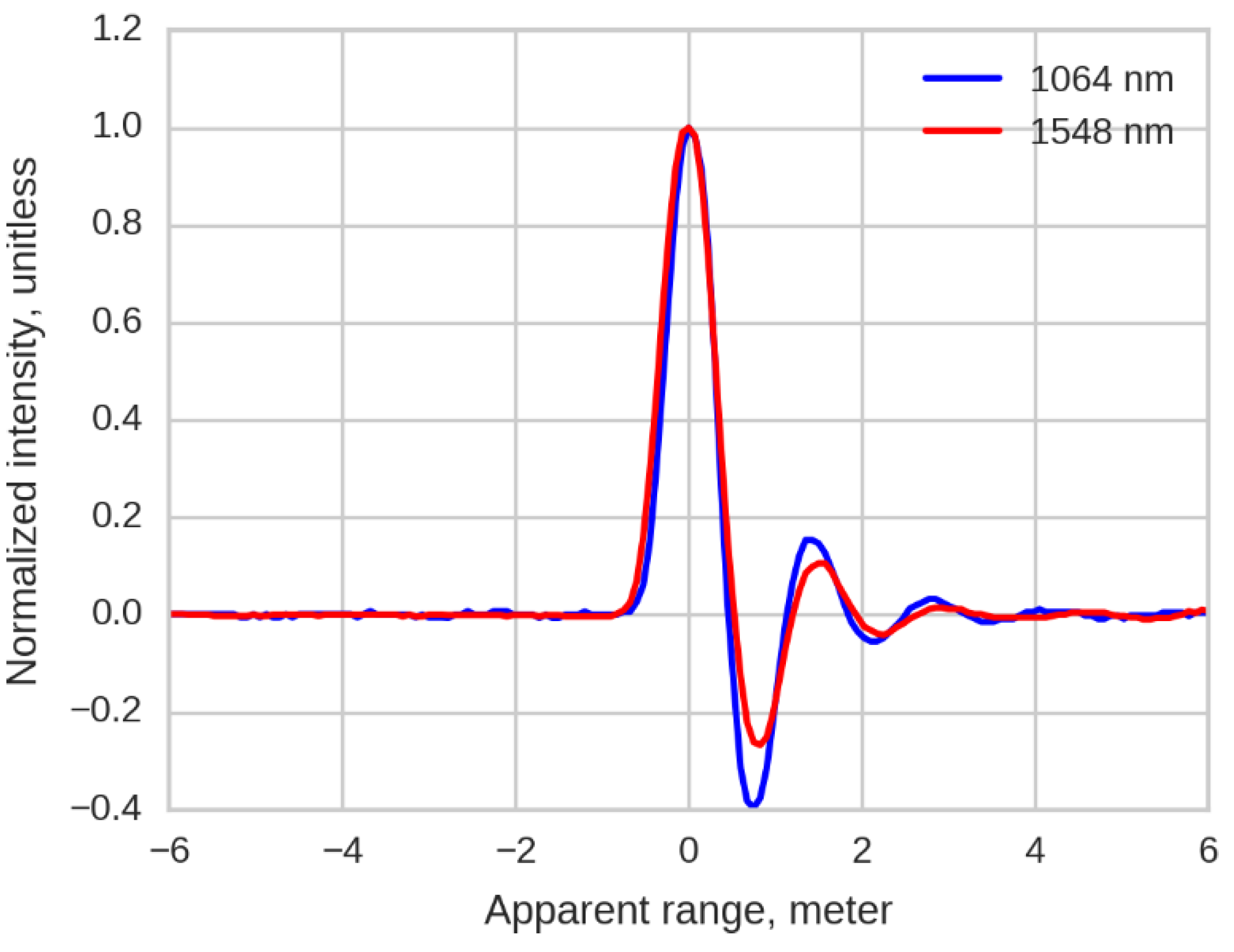
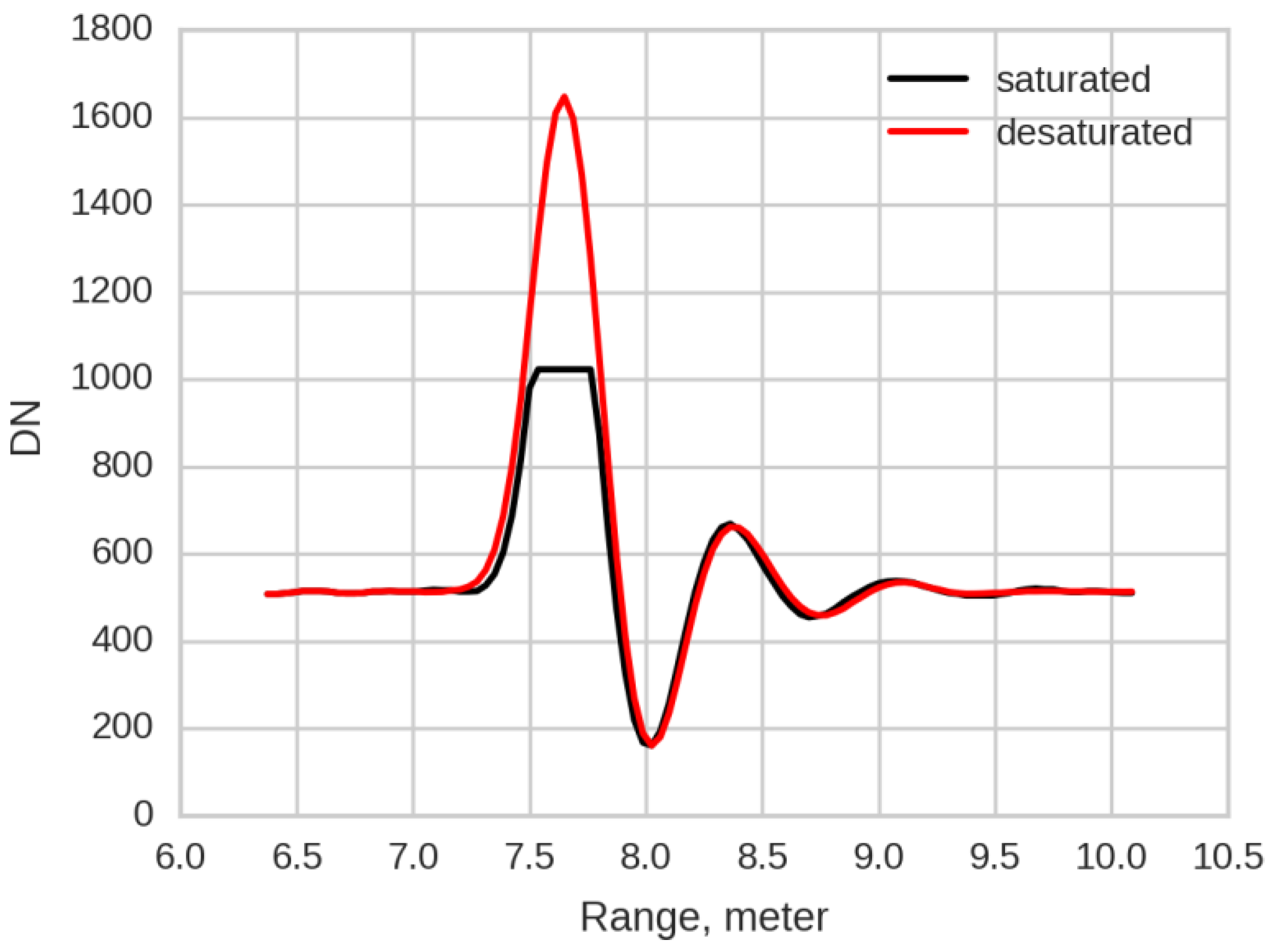
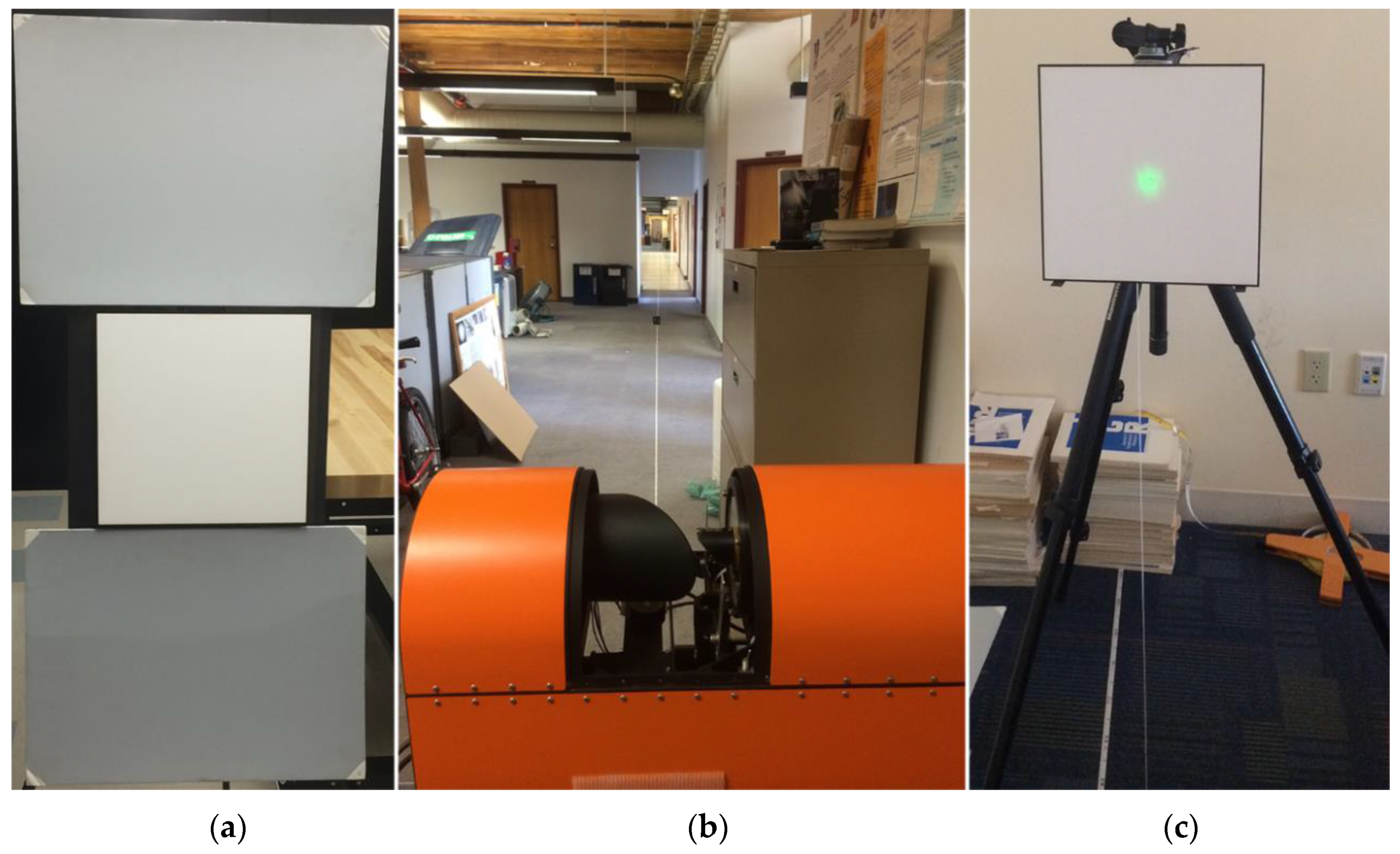
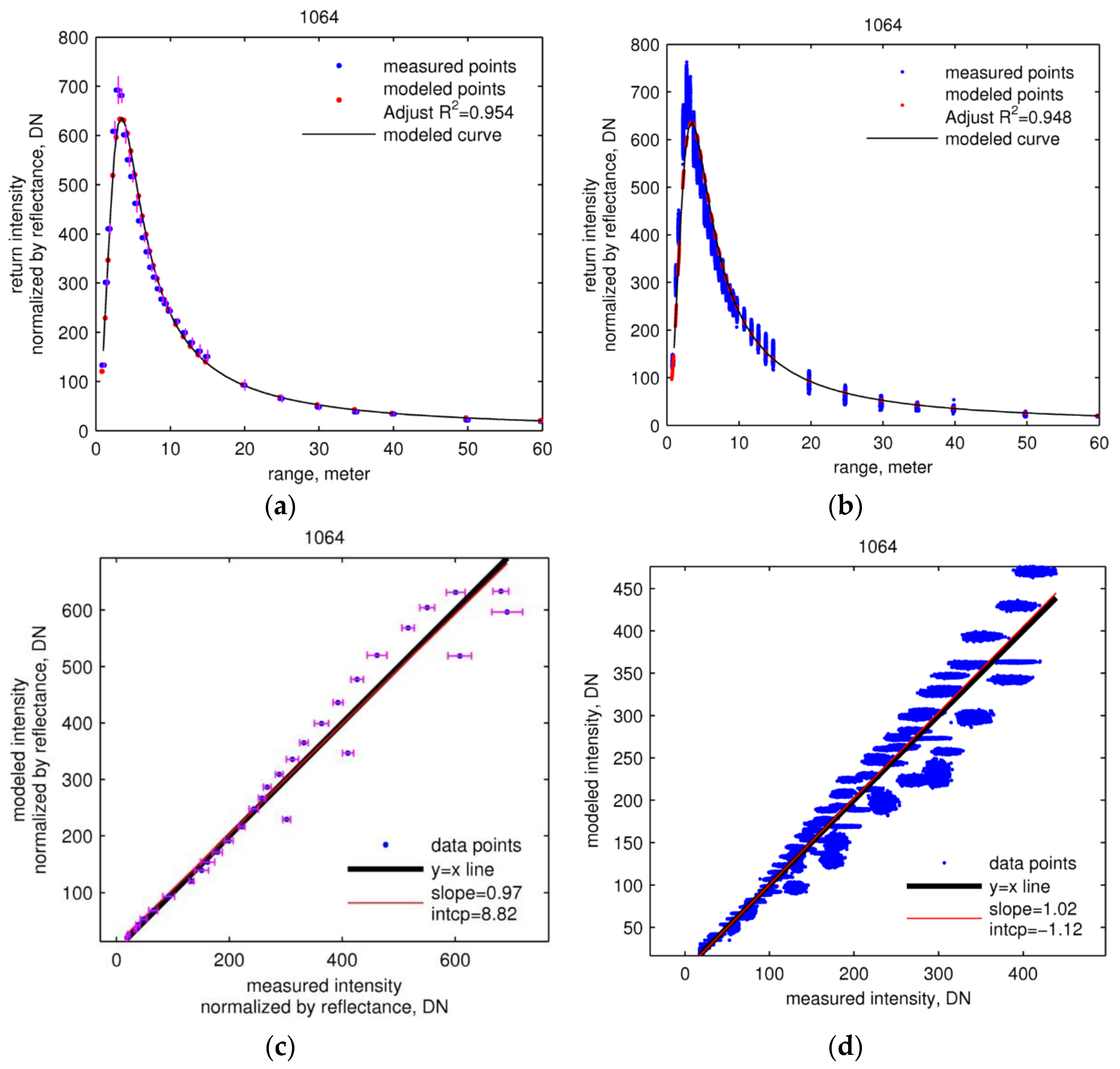
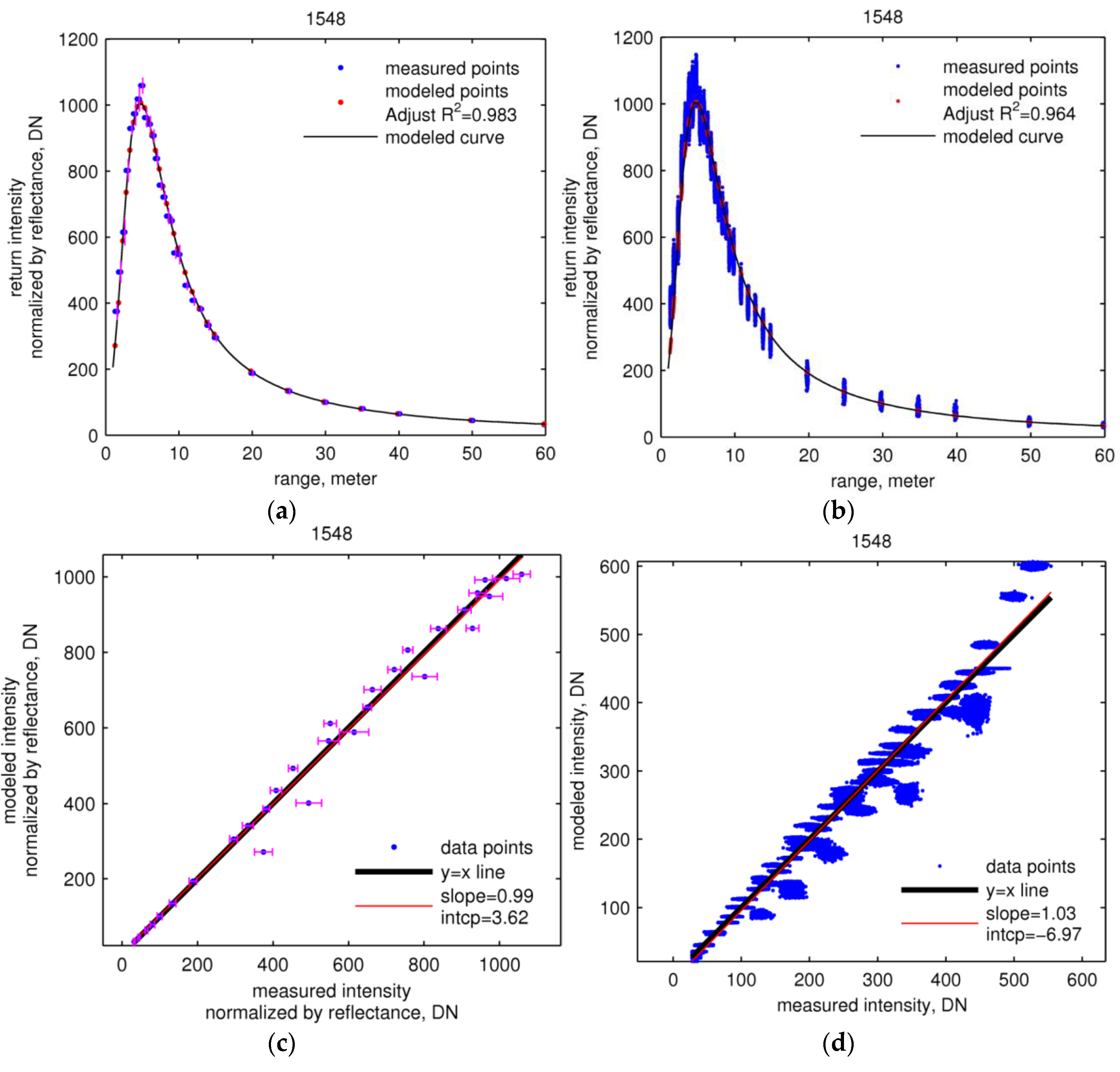
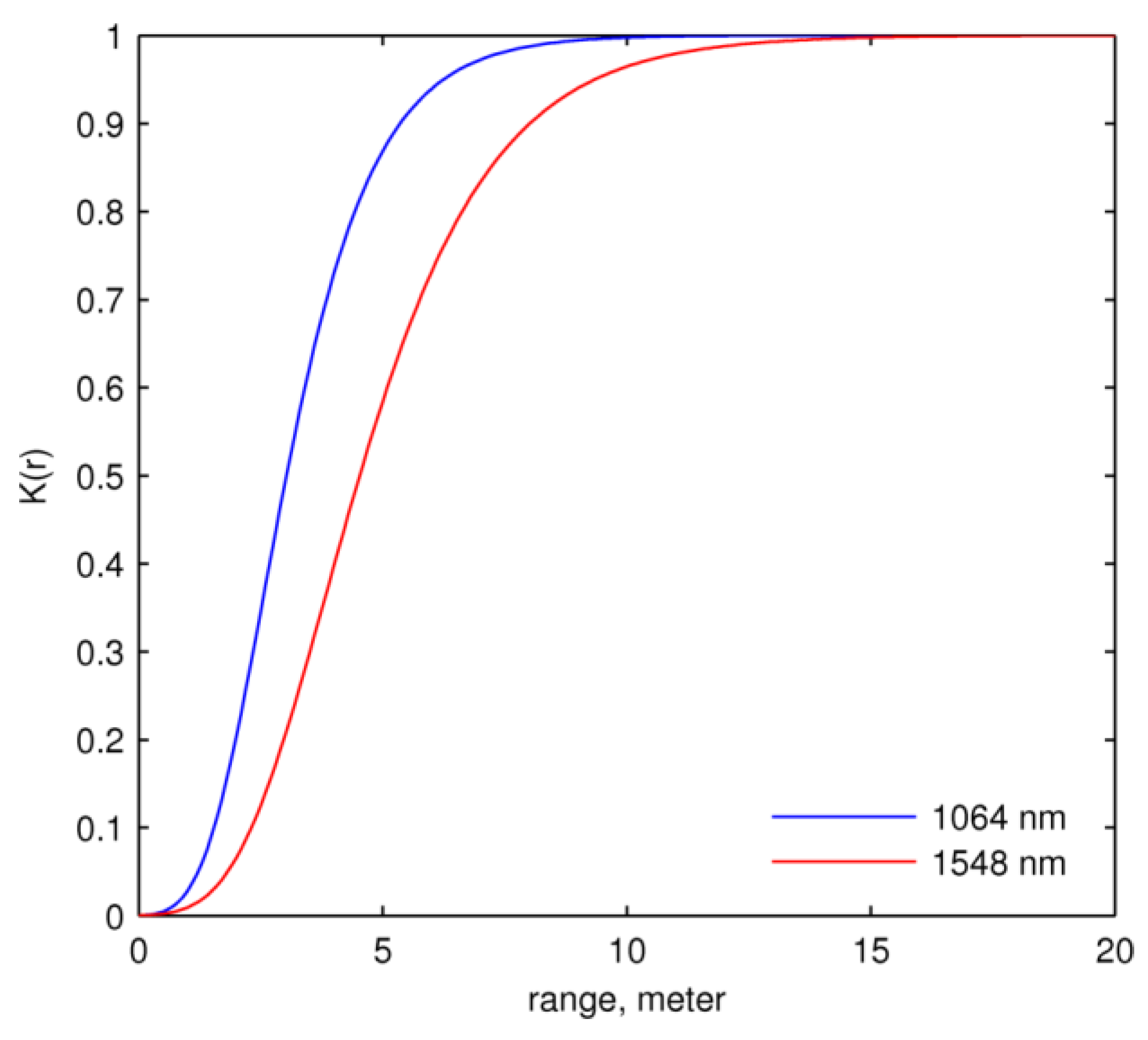
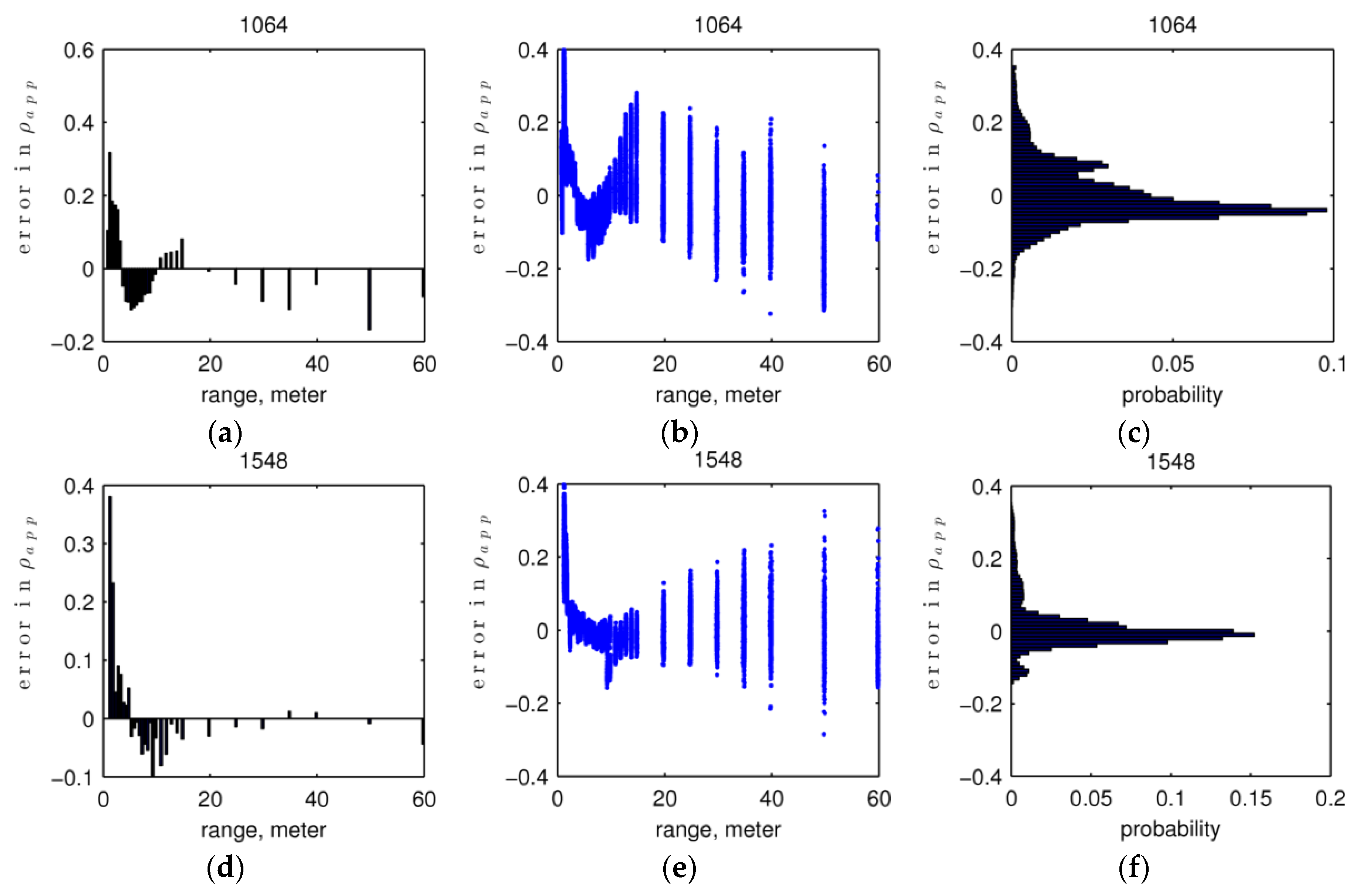
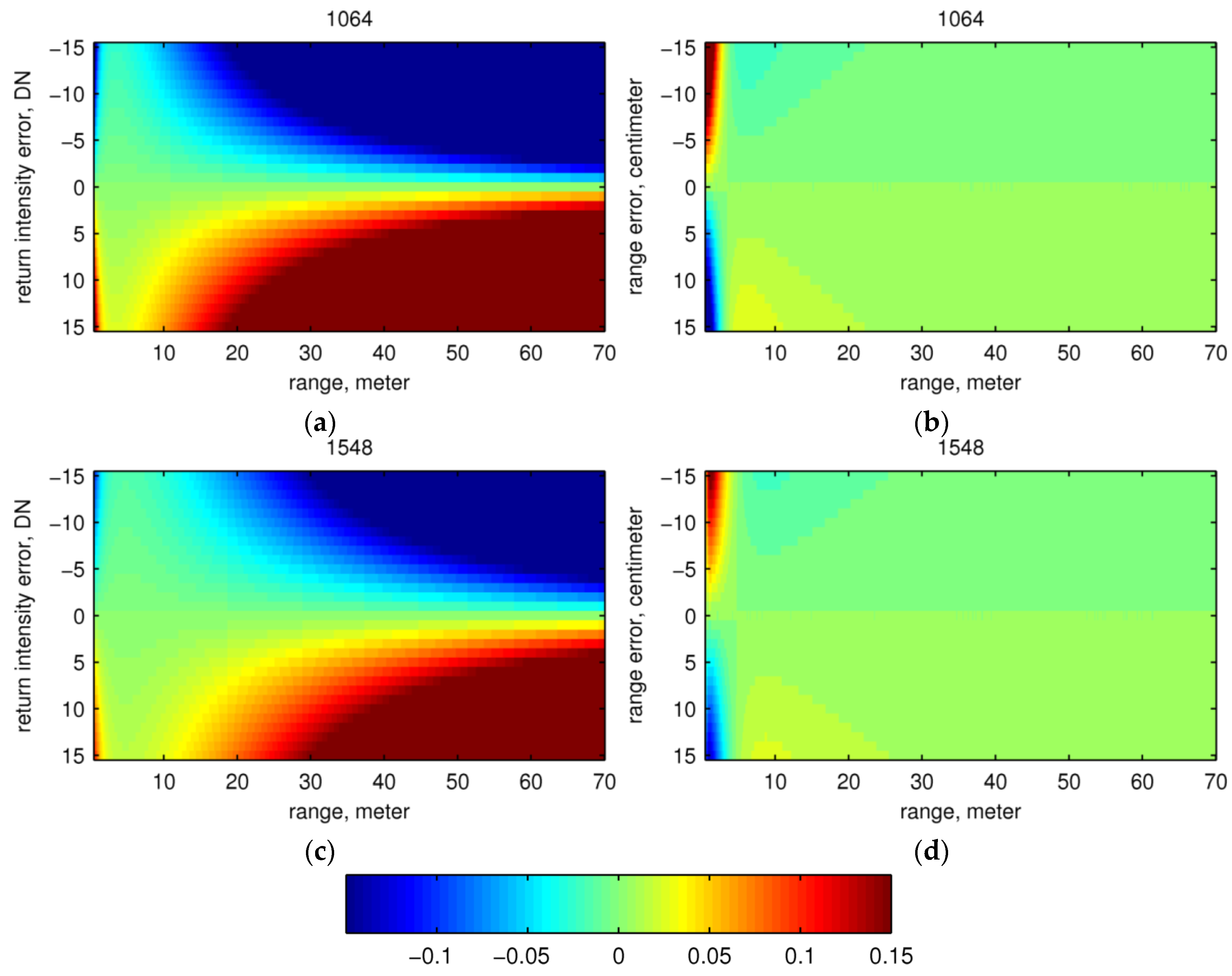
| Range (m) | Range Interval (m) | Measurement Positions |
|---|---|---|
| [0.5, 10] * | 0.5 | 20 |
| (10, 15] | 1 | 5 |
| (15, 40] | 5 | 5 |
| (40, 70] | 10 | 3 |
| Target | NIR Reflectance | SWIR Reflectance | Dimension (cm by cm) | ||
|---|---|---|---|---|---|
| Measured 1 | 2 | Measured 1 | 2 | ||
| White Spectralon panel 3 | 0.99 | 0.98 | 30.5 × 30.5 | ||
| Gray Painted Panel 1 | 0.436 | 0.574 | 0.349 | 0.447 | 38.0 × 30.5 |
| Gray Painted Panel 2 | 0.320 | 0.431 | 0.245 | 0.329 | 38.0 × 30.5 |
| Parameter | Wavelength | |
|---|---|---|
| 1064 nm | 1548 nm | |
| C0 | 5788.265818 | 22,054.218342 |
| C1 | 0.000319 | 0.000319 |
| C2 | 0.808880 | 0.540762 |
| C3 | 25,176.835032 | 25,176.835032 |
| b | 1.384297 | 1.585985 |
| Wavelength | 1064 nm | 1548 nm | |
|---|---|---|---|
| Measured vs. Modeled Intensity, Adjusted | Training 1 | 0.954 | 0.983 |
| Validation 2 | 0.948 | 0.964 | |
| RMSE of Apparent Reflectance | Training 1 | 0.108 | 0.092 |
| Validation 2 | 0.081 | 0.064 | |
© 2016 by the authors; licensee MDPI, Basel, Switzerland. This article is an open access article distributed under the terms and conditions of the Creative Commons by Attribution (CC-BY) license (http://creativecommons.org/licenses/by/4.0/).
Share and Cite
Li, Z.; Jupp, D.L.B.; Strahler, A.H.; Schaaf, C.B.; Howe, G.; Hewawasam, K.; Douglas, E.S.; Chakrabarti, S.; Cook, T.A.; Paynter, I.; et al. Radiometric Calibration of a Dual-Wavelength, Full-Waveform Terrestrial Lidar. Sensors 2016, 16, 313. https://doi.org/10.3390/s16030313
Li Z, Jupp DLB, Strahler AH, Schaaf CB, Howe G, Hewawasam K, Douglas ES, Chakrabarti S, Cook TA, Paynter I, et al. Radiometric Calibration of a Dual-Wavelength, Full-Waveform Terrestrial Lidar. Sensors. 2016; 16(3):313. https://doi.org/10.3390/s16030313
Chicago/Turabian StyleLi, Zhan, David L. B. Jupp, Alan H. Strahler, Crystal B. Schaaf, Glenn Howe, Kuravi Hewawasam, Ewan S. Douglas, Supriya Chakrabarti, Timothy A. Cook, Ian Paynter, and et al. 2016. "Radiometric Calibration of a Dual-Wavelength, Full-Waveform Terrestrial Lidar" Sensors 16, no. 3: 313. https://doi.org/10.3390/s16030313
APA StyleLi, Z., Jupp, D. L. B., Strahler, A. H., Schaaf, C. B., Howe, G., Hewawasam, K., Douglas, E. S., Chakrabarti, S., Cook, T. A., Paynter, I., Saenz, E. J., & Schaefer, M. (2016). Radiometric Calibration of a Dual-Wavelength, Full-Waveform Terrestrial Lidar. Sensors, 16(3), 313. https://doi.org/10.3390/s16030313






